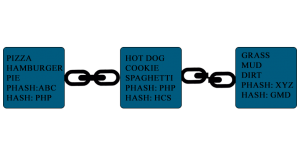It is common to hear blockchain touted as the future. A world-changing technology that will reinvent the internet, supply chains, the financial sector, and everything else. It sounds like a technology on the edge of creating an entirely new world.
So what exactly is blockchain and does it deserve its praise?
The Basics of Blockchain
To put it simply, blockchain is a new method of decentralized and immutable recordkeeping, which is a bit of a mouthful to say out loud.
The term Blockchain in itself however is generally incorrectly used. Whether a blockchain is public or permissionless can completely change the ideological hopes of the technology. The best known and largest blockchain is of the Bitcoin (BTC) cryptocurrency which is public and permissionless. This is typically the type of blockchain most people are referring to when they mention blockchain technology.
Decentralization is the de-facto buzzword for the entire cryptocurrency and blockchain universe. The reason decentralization is touted within the blockchain industry is because it means that there is no longer a single authority or entity that determines the validity of a record. You no longer need an intermediary to verify your records.
Since everybody has to agree on existing records, the changing of any records, as well as the addition of any new records, this creates the basic premise of the immutability.
The Earliest Known "Blockchain"
I found edX's use of the Yapese people and Rai Stones as a great way to not only explain blockchain, but to demonstrate a very early example of the use of what could be considered primitive blockchain technology.
The Yapese people used Rai Stones as a form of currency and the largest of these stones could weigh up to 4 tonnes. The system worked through a system of oral history and memory to determine ownership. A large Rai Stone would have multiple owners and the ownership details of each section of the stone were remembered by the tribe. In modern blockchain, each member of the tribe would be considered a node. If somebody wanted to transfer ownership of a part of the stone to somebody, they would tell the whole tribe and reach a consensus. When agreed upon, the whole tribe would remember who now owned that part of the stone.

By Eric Guinther - English Wikipedia, CC BY-SA 3.0, https://commons.wikimedia.org/w/index.php?curid=161923
When comparing this to blockchain, the same concepts exist. The record of who owned each part of the stone was remembered by the whole tribe making the recordkeeping decentralized.
The Yapese system also contained another element of the modern blockchain, immutability. Immutability in this regard means that the ownership of a stone or parts of a stone cannot change without a majority consensus of the tribe members. Bob can't transfer ownership of a part of the stone to Sally if nobody in the tribe remembers Bob as owning that part of the stone in the first place. The only way Bob would be able to steal this part of the stone is if he could convince the majority of the tribe to support his ownership.
Let's go over the concept in terms of the modern blockchain.
At its most basic level, a blockchain is a distributed journal and each block is a piece of paper. Like a piece of paper, each block is a blank page that allows anything to be written on it. Anybody can communicate to everybody else that they want to add something to the piece of paper. When a new page is ready to be added to the journal it is sent out to all the people to be confirmed and once a consensus has been met, the new page is added.
Immutability in the Modern Blockchain
The immutability of the blockchain is really where blockchain scores points over previous technologies. Due to the way the blockchain operates, it makes it near impossible to change data on the blockchain without corrupting records that already exist.
The above image is covering multiple aspects of the blockchain, where the "chaining" comes from, as well as the immutability of the records once they are entered into the blockchain. There is some frivolous example data in each block and I've also included two extra values, the "PHASH" or Previous Hash and the Hash itself of the block.
If you take a look at the second block, you'll notice the PHASH is the HASH of the first block. In order for a new block to enter the chain, it must contain verifiable data from the previous block. This is also why the third block's chain is broken, as the PHASH of the third block isn't matching the second block's HASH.
To simplify this we can go back to the example of the journal. In order for me to consider the next page as valid, it must actually have the correct subsequent page number written on it. If Bob, Sally, and Alice's journals correctly go up by one number per page, but Jack's journal skips page 3, the majority know that Jack's journal is incorrect.
The Involvement of Cryptography in Cryptocurrency
Cryptography may sound daunting, especially when most of our experiences with it can bring up thoughts like the Enigma Machine and the epic stories of breaking the code created from it. The thing to remember is that any form of obscurement through a system can be considered encryption, including Pig-Latin.
Typical encryption involves four things, the secret, the key, the function, and the cipher.
- Secret: The information you are trying to send and keep private
- Key: Tool or type of encryption used to obscure and read the Secret
- Function: The process that combines the Secret and Key
- Cipher: The result of the Function
- Secret: Pineapple
- Key: First letter appended to end with an additional suffix of -ay
- Function: Combining the Secret and Key
- Cipher: ineapplepay
Most cryptocurrencies utilize two types of cryptography. As mentioned previously, hashing is used to verify the integrity of existing data and also to input new data into the blockchain. Hashing is relatively unique to cryptocurrency in that there is no method to reverse the function and read the data since the key and function are combined into a single process.
Asymmetric Encryption Cryptography means the data is encrypted in a way that only allows an owner of a specific key to read. This is accomplished through the use of both a public and private key.
Imagine a more secure form of mail. If Bob needs to send Sally a piece of mail, it is secured so that Sally must use a retina scan to open the mail, it is then sent to Sally's address. When Sally receives the mail piece, only she should be able to open the mail. In this scenario, the lock that recognizes Sally's retina scan is the public key and her actual retina scan is the private key. In world without crime, if somebody else were to intercept the mail, they would not be able to view its contents without having Sally's retina scan or permission.
It is not a perfect example, but it highlights the basic concept of how data is sent securely over the blockchain. The public and private keys are two mathematically linked values so that anything encrypted by the public key can only be decrypted by the private key.
Making Sense of it All
Combining all of the concepts discussed so far should begin to paint a picture of the basic concepts of blockchain. Through the use of cryptography and connecting all the data together, once a record is created, it is near impossible to change. You and others are able to securely send data onto the blockchain where only the intended private party can read this data.
The ultimate dream for blockchain is to support a cryptocurrency which once widely adopted as a form of money, will remove the necessity for third party organizations. However, there are other uses for blockchain technology. Since the idea behind blockchain is the idea that data is permanent, there are also projects seeking to utilize blockchain in order for data storage or supply chain management.
How Blockchain Affects You
As confusing as the idea of blockchain may sound, it really will not affect you much at all. Just like you do not need to understand Google's search algorithm or Facebook's database structure, this technology will mostly be hidden behind menus and apps by the time the technology is ready for widespread use.
In terms of supply chain management, you may see scannable barcodes on products you enjoy showing the product's origin and how it ended up in your hands. This may prove useful to combat counterfeit products as well as control potentially sensitive products like diamonds.
Like the definitions for public and private blockchains are still intermingled, blockchain technology is in its infancy. The craze and excitement over the technology is much like dot-com bubble of 1995-2000 and much like that bubble, we will see a consolidation and reduction in the number of projects and thus products that end up reaching you.
Posted from my blog with SteemPress : http://leonox.me/2018-11-21/posts/cryptocurrency/simple-introduction-to-basics-of-blockchain-what-is-the-miracle-called-blockchain/

